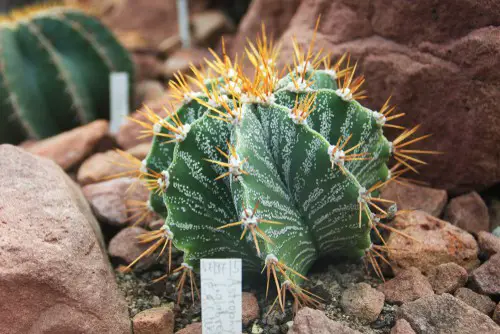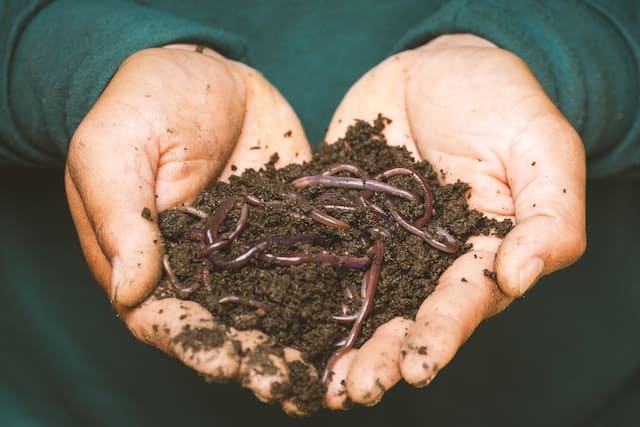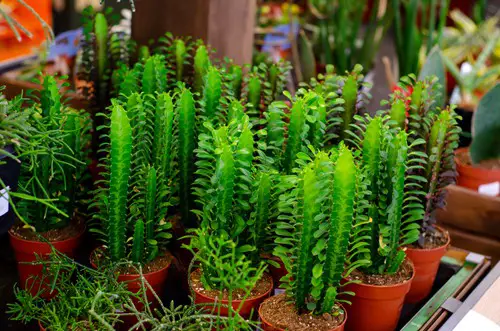Cactus and aloe vera are two popular plants that are often grown indoors. Both plants are known for their low maintenance and drought-tolerant nature, making them ideal for busy people. One question that many plant enthusiasts have is whether they can plant cactus and aloe vera together.
The answer is yes, cactus and aloe vera can be planted together. Both plants thrive in well-draining soil and prefer sunny, dry conditions. They can be planted in the same pot as long as it is large enough to accommodate both and has adequate drainage.
There are several benefits to planting cactus and aloe vera together, including providing a nice, shady spot for cactus to stay cool and helping to protect aloe from animals that might want to nibble on its succulent leaves.
In this article, we will explore the benefits of planting cactus and aloe vera together, the ideal conditions for growth, proper care and maintenance, potting and soil preferences, and the health benefits of aloe vera. We will also answer some frequently asked questions about growing these two plants together.
Understanding Cactus and Aloe Vera
You will also like these other top posts in this category:
- Planting Cabbage and Brussels Sprouts Together
- Can You Plant Berry Bushes in Valheim?
- Can You Plant Asparagus From the Store?
Characteristics of Cactus

Cacti are a type of succulent plant that are well-known for their ability to store water in their thick, fleshy leaves and stems. They are often found in arid regions and can survive in very dry conditions. Cacti come in a wide variety of shapes and sizes, with some species growing up to 60 feet tall while others are only a few inches in height.
Cacti are typically characterized by their spiny exterior, which helps protect them from predators. They also have shallow root systems that allow them to absorb water quickly during rainstorms. Some cacti even have the ability to photosynthesize at night, which helps them conserve water during the day.
Characteristics of Aloe Vera
Aloe vera is another type of succulent plant that is known for its medicinal properties. It is often used to treat burns, cuts, and other skin conditions due to its anti-inflammatory and antibacterial properties. Aloe vera has thick, fleshy leaves that store water, and it is able to survive in dry conditions.
Aloe vera plants typically grow to be around 1-2 feet tall and wide. They have a rosette shape, with leaves that grow out from a central point. Aloe vera plants also produce a tall stem that blooms with yellow or orange flowers.
Both cacti and aloe vera belong to the same family of plants, known as the Asphodelaceae family. Despite this, they have distinct differences in their appearance and growing habits. While both plants are able to store water in their leaves, cacti are typically more spiny and have shallow root systems than aloe vera plants.
How to Plant Cactus and Aloe Vera Together
When it comes to gardening, combining plants can be a great way to maximize space and create a visually appealing garden. One such combination is planting cactus and aloe vera together. Here are some things to consider when planting these two plants together.
Benefits of Planting Together
Cactus and aloe vera are both succulent plants that thrive in similar soil and light conditions. By planting them together, gardeners can take advantage of the following benefits:
1. Complementary Growth: Aloe vera provides a shady spot for cactus to stay cool, while the spiky leaves of cactus help protect aloe from animals that might want to nibble on its succulent leaves.
2. Attractive Appearance: The contrasting textures and colors of cactus and aloe vera can create an eye-catching display in any garden.
3. Easy Maintenance: Both cactus and aloe vera require minimal watering and can thrive in well-draining soil. This makes them ideal for busy gardeners who don’t have a lot of time to spend on maintenance.
Potential Challenges
While planting cactus and aloe vera together can be advantageous, there are some potential challenges to consider:
- Different Watering Needs: While both plants require minimal watering, aloe vera needs more water than cactus. This means that gardeners will need to be careful not to overwater the cactus when watering the aloe vera.
- Different Soil Requirements: While cactus and aloe vera both prefer well-draining soil, they have slightly different soil requirements. Cactus prefers soil that is slightly acidic, while aloe vera prefers soil that is slightly alkaline. Gardeners will need to find a balance between these two soil types to ensure that both plants thrive.
- Different Light Requirements: While both plants prefer sunny, dry conditions, cactus can tolerate more direct sunlight than aloe vera. Gardeners will need to find a balance between providing enough sunlight for the cactus and not exposing the aloe vera to too much direct sunlight.
Ideal Conditions for Growth

Light Requirements
Cacti and aloe vera plants have different light requirements, but they can still be planted together if the right conditions are met. Cacti prefer bright, direct sunlight, while aloe vera plants prefer indirect light.
Therefore, it is important to place the plants in a location that receives bright, indirect light. Placing the plants near a south-facing window is a good option.
Water Requirements
Both cacti and aloe vera plants are desert plants and do not require much water. However, aloe vera plants require more water than cacti. When planting cacti and aloe vera together, it is important to use a well-draining soil mix that can hold moisture while also allowing excess water to drain away. This will prevent the roots from rotting due to over-watering.
Temperature Preferences
Cacti and aloe vera plants prefer warm temperatures and can tolerate a wide range of temperatures. However, it is important to avoid exposing the plants to extreme temperature fluctuations.
Keep the plants away from cold drafts and air conditioning vents. During the winter months, it is important to protect the plants from frost by bringing them indoors or covering them with a frost cloth.
Proper Care and Maintenance
Cactus and aloe vera are both low-maintenance plants that require minimal care. However, proper care and maintenance are essential to ensure that they thrive and grow healthy. In this section, we will discuss the different aspects of caring for and maintaining cactus and aloe vera plants.
Watering Techniques
Watering is a crucial aspect of caring for cactus and aloe vera plants. Both plants are succulents that store water in their leaves and stems, making them drought-tolerant. Overwatering can lead to root rot and fungal diseases, while underwatering can cause the plants to wilt and die.
When watering cactus and aloe vera plants, it is essential to water deeply but infrequently. Allow the soil to dry out completely between watering sessions. During the summer months, when the plants are actively growing, water once a week. In winter, reduce watering to once every two to three weeks.
Fertilizing Needs

Cactus and aloe vera plants do not require frequent fertilizing. However, they will benefit from occasional feeding during the growing season. Use a balanced fertilizer with an NPK ratio of 10-10-10 or 5-10-10.
Apply the fertilizer sparingly, following the manufacturer’s instructions. Overfertilizing can lead to burnt roots and damage to the plant. Fertilize cactus and aloe vera plants once every two to three months during the growing season.
Disease and Pest Control
Cactus and aloe vera plants are relatively disease and pest-resistant. However, they are susceptible to certain fungal diseases and pests. The most common diseases that affect cactus and aloe vera plants are root rot and fungal infections.
To prevent fungal diseases, avoid overwatering and ensure that the soil is well-draining. If you notice any signs of fungal infection, such as yellowing leaves or black spots on the stem, remove the affected parts immediately.
Pests that commonly affect cactus and aloe vera plants include mealybugs and spider mites. To control pests, use a mild insecticidal soap or neem oil. Apply the solution to the affected areas, following the manufacturer’s instructions.
Potting and Soil Preferences
Choosing the Right Pot
Both cactus and aloe vera plants require well-draining soil and pots with drainage holes to prevent water from accumulating in the roots and causing root rot. When selecting a pot for planting, it is important to choose a pot that is slightly larger than the root ball of the plant. This will allow the plant to grow and expand its root system over time.
It is also important to choose a pot that is made of a material that will not retain moisture, such as terracotta or clay. These materials allow for air circulation and can help to prevent overwatering. Plastic pots are not recommended for cactus or aloe vera plants as they can trap moisture and lead to root rot.
Selecting the Best Soil Mix

Aloe vera plants require soil with exceptional drainage. The best aloe plant potting soil contains a mix of sand, perlite, pumice, and pine bark fines. Aloe vera prefers a neutral to alkaline pH, from 7.0 to 8.5, but can tolerate slightly acidic soils. Regular potting soil is not recommended for aloe vera plants as it can retain too much moisture and lead to root rot.
Cactus potting mix is the best choice for planting cactus and aloe vera together. The mix should contain coarse sand, perlite, and pumice to ensure proper drainage. A succulent mix can also be used if cactus potting mix is not available. Compost should be avoided as it can retain moisture and lead to root rot.
Health Benefits of Aloe Vera
Aloe vera is a succulent plant that has been used for centuries for its medicinal properties. It is known for its healing properties and is used in many skincare products. Aloe vera is also edible and can be used to make juices and smoothies. In this section, we will explore the nutritional content and medicinal uses of aloe vera.
Nutritional Content
Aloe vera is a rich source of vitamins and minerals. It contains vitamin C, vitamin E, and beta-carotene. Aloe vera also contains calcium, magnesium, and potassium. It is also a good source of amino acids, which are the building blocks of protein.
Medicinal Uses
Aloe vera has many health benefits. It is known for its antibacterial properties and is used to treat skin conditions such as acne, eczema, and psoriasis. Aloe vera is also used to treat wounds and burns. It can help to reduce inflammation and promote healing.
Aloe vera is also used to treat digestive issues such as constipation and irritable bowel syndrome. It can help to soothe the digestive tract and reduce inflammation. Aloe vera is also used to boost the immune system and promote overall health.
Conclusion
Pllanting cactus and aloe vera together can be a great way to add to the aesthetic of a garden, but gardeners should be aware of potential health hazards associated with it. It is important to wear protective gloves when handling either plant, as both have sharp spines and can cause injury.
Additionally, cats should be kept away from aloe vera plants, as the plant is toxic to them.
Both cacti and aloe vera thrive in well-draining soil and prefer sunny, dry conditions. They can be planted in the same pot as long as it is large enough to accommodate both and has adequate drainage.
Aloe vera provides a nice, shady spot for cactus to stay cool, and the spiky leaves of cactus help protect aloe from animals that might want to nibble on its succulent leaves.
It is also important to be aware of each plant’s individual needs. While both are relatively low-maintenance, they still require proper care to thrive. Cacti, for example, should not be overwatered, as this can lead to root rot. Aloe vera, on the other hand, requires more water than cacti and should be watered thoroughly but allowed to dry out between waterings.
Frequently Asked Questions
What are some plants that can be planted with aloe vera?
Aloe vera is a versatile plant that can be planted with a variety of other plants. Some common plants that can be planted with aloe vera include succulents, herbs, and other plants that prefer well-draining soil.
What type of soil should be used when planting aloe vera?
Aloe vera prefers well-draining soil that is rich in nutrients. A good soil mix for aloe vera should contain a combination of sand, perlite, and peat moss. It is important to avoid using heavy, clay-based soils that can hold too much moisture and lead to root rot.
Can aloe vera and cactus be planted together in the same pot?
Yes, aloe vera and cactus can be planted together in the same pot. In fact, planting these two plants together can be beneficial as they have similar watering and light requirements. However, it is important to choose a pot that is large enough to accommodate both plants and to use a well-draining soil mix.
What are the benefits of planting aloe vera and cactus together?
Planting aloe vera and cactus together can have several benefits. Aloe vera can provide a shady spot for cactus to stay cool, while the spiky leaves of cactus can help protect aloe vera from animals that might want to nibble on its succulent leaves.
Additionally, both plants have similar watering and light requirements, making them easy to care for together.
What are some differences between cactus and aloe vera?
While cactus and aloe vera are both succulent plants, there are some differences between the two. Cactus plants typically have spines or needles, while aloe vera has smooth, fleshy leaves. Additionally, cactus plants are often more drought-tolerant than aloe vera and can go longer periods without water.
What are some tips for growing aloe vera and cactus together?
When growing aloe vera and cactus together, it is important to choose a pot that is large enough to accommodate both plants and to use a well-draining soil mix. It is also important to place the pot in a location that receives plenty of bright, indirect sunlight.
When watering, it is important to allow the soil to dry out completely between waterings to prevent root rot. Finally, it is important to monitor the plants for signs of pests or disease and to take appropriate action if necessary.

Hey, I’m Lisa and I’ve been an avid gardener for over 30 years. I love writing, talking and living in the garden! Feel free to connect with me on my socials below


